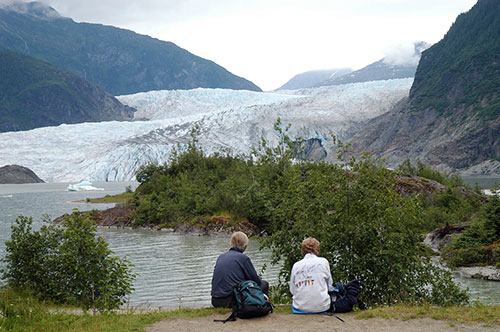
Southeast Alaska: Melting Funds for Tongass Tourism GemBy LAURA COOPER April 11, 2014
A must-see for most tourists is the Mendenhall Glacier, a natural wonder just 14 miles from downtown Juneau. As one of the most road-accessible glaciers in the world, Mendenhall tops the list as the most visited Forest Service site in Alaska. Surrounded by lush rainforest and towering mountains, the Mendenhall Glacier is part of a 5,800 acre recreational area managed by the Forest Service as part of the 17-million-acre Tongass National Forest.
Mendenhall Glacier, a natural wonder just 14 miles from downtown Juneau
Unlike most recreation sites across the Tongass, most visitors will experience the Mendenhall Glacier via commercial tour operators like Gastineau Guiding Company. These companies rely on the Forest Service to maintain the recreational area while adapting to the evolving tourism market and visitor trends. But lately the Forest Service appears unable to keep pace and the Mendenhall is showing signs of wear and tear. In the past 15 years, the number of visitors to Mendenhall has doubled and the expectation is that this trend will continue. The Forest Service anticipates hosting just over 440,000 visitors this summer at the Mendenhall Glacier Visitor Center and Interpretative site. “The 2014 season looks to be strong,” said Kirby Day, manager of port operations and passenger logistics in Alaska for Princess Cruises. “And with more cruise passengers comes additional visitation at Mendenhall and pressure on the outdated and aging public facilities including the visitor center, trails, restrooms, and parking/staging areas.” The Forest Service acknowledges that burgeoning demand is outpacing the agency’s available resources and its capacity to improve access, services and facilities at the glacier. John Neary, Mendenhall Glacier visitor center director, said the current year budget is just enough to “keep the doors open.” Beyond covering essential operational costs, the Forest Service’s budget for the Mendenhall is inadequate. The facility needs $800,000 in deferred maintenance for repairs to deteriorating rock walls, stairways and path systems, and roofing on structures; an estimated $8,000,000 for additional restrooms, bus and parking structures, trails and platforms for safe bear viewing, and restoration of salmon habitat; and $200,000 for programs and staffing to ensure safe bear viewing, adequate visitor management, and optimal interpretation. In recent years, Forest Service investment in the Mendenhall Glacier Visitor Center programs and facilities has plummeted. Between 2013 and 2014, funding allocated from congressional appropriations was cut in half from $200,000 to just over $100,000 covering only 10 percent of the annual operating and maintenance budget. With the drop in federal investment, the Forest Service has increasingly relied on revenue collected from fees paid by businesses and visitors to cover basic costs. These funds are meant to be used to enhance facilities and services in order to provide visitors with a quality experience. The decline of Forest Service investment in the Mendenhall Glacier Visitor Center parallels a sharp decrease in federal investment for recreation and visitor-related services across the Tongass. Since 2009, congressionally appropriated funding for Tongass recreation has dropped by nearly half. During the same general timeframe, Southeast Alaska’s visitor industry employment has increased by seven percent and employment income in this sector has seen a ten percent increase. Southeast Alaska’s Tongass National Forest is a bucket-list destination for world travelers and their trips help propel the region’s economy. With 80 percent of the region’s land base in the Tongass National Forest, the visitor industry depends upon the Forest Service to be a strong and effective partner in delivering world-class experiences to their clients. If the partnership is to thrive, the funding problem at Mendenhall Glacier and across the region needs to be fixed. Any solution must include increasing congressional appropriations for the Tongass recreation program as well as finding ways to leverage additional resources through new partnerships and alternative funding sources.
E-mail your news &
photos to editor@sitnews.us
|
||
